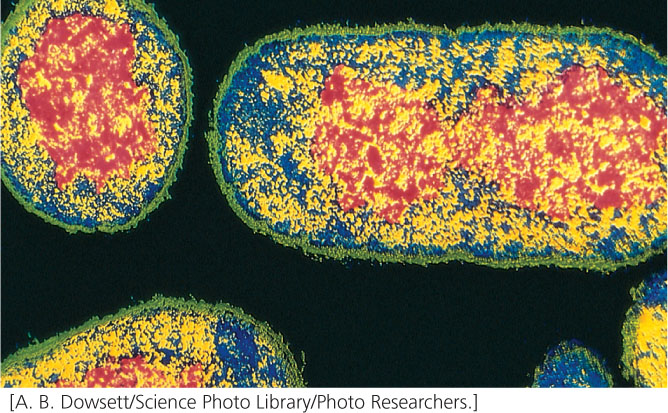2.1 Prokaryotic and Eukaryotic Cells Differ in a Number of Genetic Characteristics
Biologists traditionally classify all living organisms into two major groups, the prokaryotes and the eukaryotes (Figure 2.1). A prokaryote is a unicellular organism with a relatively simple cell structure. A eukaryote has a compartmentalized cell structure with components bounded by intracellular membranes; eukaryotes are either unicellular or multicellular.

Research indicates that a division of life into two major groups, the prokaryotes and eukaryotes, is not so simple. Although similar in cell structure, prokaryotes include at least two fundamentally distinct types of bacteria: the eubacteria (true bacteria) and the archaea (ancient bacteria). An examination of equivalent DNA sequences reveals that eubacteria and archaea are as distantly related to one another as they are to the eukaryotes. Although eubacteria and archaea are similar in cell structure, some genetic processes in archaea (such as transcription) are more similar to those in eukaryotes, and the archaea are actually closer evolutionarily to eukaryotes than to eubacteria. Thus, from an evolutionary perspective, there are three major groups of organisms: eubacteria, archaea, and eukaryotes. In this book, the prokaryotic–eukaryotic distinction will be made frequently, but important eubacterial–archaeal differences also will be noted.
From the perspective of genetics, a major difference between prokaryotic and eukaryotic cells is that a eukaryote has a nuclear envelope, which surrounds the genetic material to form a nucleus and separates the DNA from the other cellular contents. In prokaryotic cells, the genetic material is in close contact with other components of the cell—a property that has important consequences for the way in which genes are controlled (Figure 2.2).

Another fundamental difference between prokaryotes and eukaryotes lies in the packaging of their DNA. In eukaryotes, DNA is closely associated with a special class of proteins, the histones, to form tightly packed chromosomes (Figure 2.3). This complex of DNA and histone proteins is termed chromatin, which is the stuff of eukaryotic chromosomes. Histone proteins limit the accessibility of enzymes and other proteins that copy and read the DNA, but they enable the DNA to fit into the nucleus. Eukaryotic DNA must separate from the histones before the genetic information in the DNA can be accessed. Archaea also have some histone proteins that complex with DNA, but the structure of their chromatin is different from that found in eukaryotes. Eubacteria do not possess histones; so their DNA does not exist in the highly ordered, tightly packed arrangement found in eukaryotic cells. The copying and reading of DNA are therefore simpler processes in eubacteria.

Genes of prokaryotic cells are generally on a single, circular molecule of DNA—the chromosome of a prokaryotic cell. In eukaryotic cells, genes are located on multiple, usually linear DNA molecules (multiple chromosomes). Eukaryotic cells therefore require mechanisms that ensure that a copy of each chromosome is faithfully transmitted to each new cell. However, this generalization—a single, circular chromosome in prokaryotes and multiple, linear chromosomes in eukaryotes—is not always true. A few bacteria have more than one chromosome, and important bacterial genes are frequently found on other DNA molecules called plasmids (see Chapter 9). Furthermore, in some eukaryotes, a few genes are located on circular DNA molecules found in certain organelles (see Chapter 11).
CONCEPTS
Organisms are classified as prokaryotes or eukaryotes, and prokaryotes consist of archaea and eubacteria. A prokaryote is a unicellular organism that lacks a nucleus and its genome is usually a single chromosome. Eukaryotes are either unicellular or multicellular, their cells possess a nucleus, their DNA is complexed to histone proteins, and their genomes consist of multiple chromosomes.
 CONCEPT CHECK 1
CONCEPT CHECK 1List several characteristics that eubacteria and archaea have in common and that distinguish them from eukaryotes.
Viruses are neither prokaryotic nor eukaryotic because they do not possess a cellular structure. Viruses are actually simple structures composed of an outer protein coat surrounding nucleic acid (either DNA or RNA; Figure 2.4). Neither are viruses primitive forms of life: they can reproduce only within host cells, which means that they must have evolved after cells, not before. In addition, viruses are not an evolutionarily distinct group but are most closely related to their hosts: the genes of a plant virus are more similar to those in a plant cell than to those in animal viruses, which suggests that viruses evolved from their hosts, rather than from other viruses. The close relationship between the genes of virus and host makes viruses useful for studying the genetics of host organisms.
